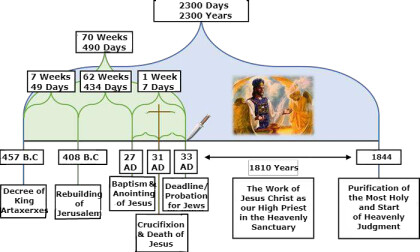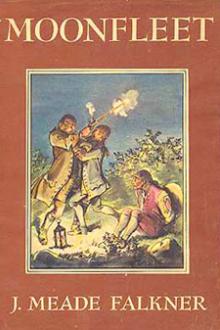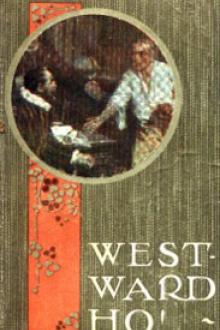Iron Throne by Ellen Gould-Harmon (red queen free ebook .txt) 📖

- Author: Ellen Gould-Harmon
Book online «Iron Throne by Ellen Gould-Harmon (red queen free ebook .txt) 📖». Author Ellen Gould-Harmon
William Miller had no sympathy with those influences that led to fanaticism. He declared, with Luther, that every spirit should be tested by the word of God. "The devil," said Miller, "has great power over the minds of some at the present day. And how shall we know what manner of spirit they are of? The Bible answers: 'By their fruits ye shall know them.'. . . There are many spirits gone out into the world; and we are commanded to try the spirits. The spirit that does not cause us to live soberly, righteously, and godly, in this present world, is not the Spirit of Christ. I am more and more convinced that Satan has much to do in these wild movements. . . . Many among us who pretend to be wholly sanctified, are following the traditions of men, and apparently are as ignorant of truth as others who make no such pretensions."--Bliss, pages 236, 237.
"The spirit of error will lead us from the truth; and the Spirit of God will lead us into truth. But, say you, a man may be in an error, and think he has the truth. What then? We answer, The Spirit and word agree. If a man judges himself by the word of God, and finds a perfect harmony through the whole word, then he must believe he has the truth; but if he finds the spirit by which he is led does not harmonize with the whole tenor of God's law or Book, then let him walk carefully, lest he be caught in the snare of the devil."-- The Advent Herald and Signs of the Times Reporter, vol. 8, No. 23 (Jan. 15, 1845). "I have often obtained more evidence of inward piety from a kindling eye, a wet cheek, and a choked utterance, than from all the noise of Christendom."--Bliss, page 282.
In the days of the Reformation its enemies charged all the evils of fanaticism upon the very ones who were labouring most earnestly against it. A similar course was pursued by the opposers of the advent movement. And not content with misrepresenting and exaggerating the errors of extremists and fanatics, they circulated unfavourable reports that had not the slightest semblance of truth. These persons were actuated by prejudice and hatred. Their peace was disturbed by the proclamation of Christ at the door. They feared it might be true, yet hoped it was not, and this was the secret of their warfare against Adventists and their faith.
The fact that a few fanatics worked their way into the ranks of Adventists is no more reason to decide that the movement was not of God than was the presence of fanatics and deceivers in the church in Paul's or Luther's day a sufficient excuse for condemning their work. Let the people of God arouse out of sleep and begin in earnest the work of repentance and reformation; let them search the Scriptures to learn the truth as it is in Jesus; let them make an entire consecration to God, and evidence will not be wanting that Satan is still active and vigilant. With all possible deception he will manifest his power, calling to his aid all the fallen angels of his realm.
It was not the proclamation of the second advent that caused fanaticism and division. These appeared in the summer of 1844, when Adventists were in a state of doubt and perplexity concerning their real position. The preaching of the first angel's message and of the "midnight cry" tended directly to repress fanaticism and dissension. Those who participated in these solemn movements were in harmony; their hearts were filled with love for one another and for Jesus, whom they expected soon to see. The one faith, the one blessed hope, lifted them above the control of any human influence, and proved a shield against the assaults of Satan.
"While the bridegroom tarried, they all slumbered and slept. And at midnight there was a cry made, Behold, the bridegroom cometh; go ye out to meet him. Then all those virgins arose, and trimmed their lamps." Matthew 25:5-7. In the summer of 1844, midway between the time when it had been first thought that the 2300 days would end, and the autumn of the same year, to which it was afterward found that they extended, the message was proclaimed in the very words of Scripture: "Behold, the Bridegroom cometh!"
THE PROPHECY OF 2,300 DAYS/ YEARS

One Prophetic Day = One Literal Year
34 According to the number of the days in which you spied out the land, forty days, for each day you shall bear your guilt one year, namely forty years, and you shall know My rejection. (Numbers 14:34) 6 And when you have completed them, lie again on your right side; then you shall bear the iniquity of the house of Judah forty days. I have laid on you a day for each year (Ezekiel 4:6)
457 BC – 1844 AD = 2300 Days/ Years. 14 And he said unto me, Unto two thousand and three hundred days; then shall the sanctuary be cleansed. (Daniel 8:14) 24 “Seventy weeks are determined For your people and for your holy city, To finish the transgression, To make an end of sins, To make reconciliation for iniquity, To bring in everlasting righteousness, To seal up vision and prophecy, And to anoint the Most Holy (Daniel 9:24)
457 B.C – The decree to rebuild and restore Jerusalem (Order of Artaxerxes). 25 …From the going forth of the command to restore and to build Jerusalem unto the Messiah the Prince shall be seven weeks, and threescore and two weeks: the street shall be built again, and the wall, even in troublous times. (Daniel 9:25)
408 B.C – The Rebuilding of Jerusalem
27 A.D – The Baptism and Unction of Jesus Christ (the Messiah). 27 Then he shall confirm a covenant with many for one week; But in the middle of the week He shall bring an end to sacrifice and offering. (Daniel 9:27)
31 A.D – The Crucifixion of Jesus Christ. 26 “And after the sixty-two weeks
Messiah shall be cut off, but not for Himself; And the people of the prince who is to come Shall destroy the city and the sanctuary. The end of it shall be with a flood, And till the end of the war desolations are determined. 27 Then he shall confirm a covenant with many for one week;
But in the middle of the week He shall bring an end to sacrifice and offering. (Daniel 9:26-27)
34 A.D – The stoning of Stephen [End of term for Jews and the gospel preached to the Gentiles/ world] 14 And this gospel of the kingdom shall be preached in all the world for a witness unto all nations; and then shall the end come. (Matthew 24:14) 46 Then Paul and Barnabas grew bold and said, “It was necessary that the word of God should be spoken to you first; but since you reject it, and judge yourselves unworthy of everlasting life, behold, we turn to the Gentiles. (Acts 13:46)
70 A.D – The Destruction of Jerusalem 1 Then Jesus went out and departed from the temple, and His disciples came up to show Him the buildings of the temple. 2 And Jesus said to them, “Do you not see all these things? Assuredly, I say to you, not one stone shall be left here upon another, that shall not be thrown down.”. (Matthew 24:1,2) 15 “Therefore when you see the ‘abomination of desolation,’[a] spoken of by Daniel the prophet, standing in the holy place” (whoever reads, let him understand), 21 For then there will be great tribulation, such as has not been since the beginning of the world until this time, no, nor ever shall be (Matthew 24: 15, 21)
1844 A.D – Purification of the Most Holy and the Start of Judgment in Heaven.
1810 Days/ Years - The work of Jesus Christ as our High Priest as our High Priest in the Heavenly Sanctuary. 14 Seeing then that we have a great High Priest who has passed through the heavens, Jesus the Son of God, let us hold fast our confession. 15 For we do not have a High Priest who cannot sympathize with our weaknesses, but was in all points tempted as we are, yet without sin. 16 Let us therefore come boldly to the throne of grace, that we may obtain mercy and find grace to help in time of need (Hebrews 4:14-16)
That which led to this movement was the discovery that the decree of Artaxerxes for the restoration of Jerusalem, which formed the starting point for the period of the 2300 days, went into effect in the autumn of the year 457 B.C., and not at the beginning of the year, as had been formerly believed. Reckoning from the autumn of 457, the 2300 years terminate in the autumn of 1844. (See Appendix note for page 329.) Arguments drawn from the Old Testament types also pointed to the autumn as the time when the event represented by the "cleansing of the sanctuary" must take place. This was made very clear as attention was given to the manner in which the types relating to the first advent of Christ had been fulfilled.
The slaying of the Passover lamb was a shadow of the death of Christ. Says Paul: "Christ our Passover is sacrificed for us." 1 Corinthians 5:7. The sheaf of first fruits, which at the time of the Passover was waved before the Lord, was typical of the resurrection of Christ. Paul says, in speaking of the resurrection of the Lord and of all His people: "Christ the first fruits; afterward they that are Christ's at His coming." 1 Corinthians 15:23. Like the wave sheaf, which was the first ripe grain gathered before the harvest, Christ is the first fruits of that immortal harvest of redeemed ones that at the future resurrection shall be gathered into the garner of God.
These types were fulfilled, not only as to the event, but as to the time. One of the fourteenth day of the first Jewish month, the very day and month on which for fifteen long centuries the Passover lamb had been slain, Christ, having eaten the Passover with His disciples, instituted that feast which was to commemorate His own death as "the Lamb of God, which taketh away the sin of the world." That same night He was taken by wicked hands to be crucified and slain. And as the antitype of the wave sheaf our Lord was raised from the dead on the third day, "the first fruits of them that slept," a sample of all the resurrected just, whose "vile body" shall be changed, and "fashioned like unto His glorious body." Verse 20; Philippians 3:21.
In like manner the types which relate to the second advent must be fulfilled at the time pointed out in the symbolic service. Under the Mosaic system the cleansing of the sanctuary, or the great Day of Atonement, occurred on the tenth day of the seventh Jewish month (Leviticus 16:29-34), when the high priest, having made an atonement for all Israel, and thus removed their sins from the sanctuary, came forth and blessed the people. So it was believed that Christ, our great High Priest, would appear to purify the earth by the destruction of sin and sinners, and to bless His waiting people with immortality. The tenth day of the seventh month, the great Day of Atonement, the time of the cleansing of the sanctuary, which in the year 1844 fell upon the twenty-second of October, was regarded as the time of the Lord's coming. This was in harmony with the proofs already presented that the 2300 days would terminate in the autumn, and the conclusion seemed irresistible.
In the parable of Matthew 25 the time of waiting and slumber is followed by the coming of the bridegroom. This was in accordance with the arguments just presented, both from prophecy and from the types. They carried strong conviction of their truthfulness; and the "midnight cry" was heralded by thousands of believers. Like a tidal wave the movement swept over the land. From city to city, from village to village, and into remote country places it went, until the waiting people of God were fully aroused. Fanaticism disappeared before this proclamation like early frost before the rising sun.
Believers saw their doubt and perplexity removed, and hope and courage animated their hearts. The work was free from those extremes which are ever manifested when there is human excitement without the controlling influence of the word and Spirit of God. It was similar in character to those seasons of humiliation and returning unto the Lord which among ancient Israel followed messages of reproof from His servants. It bore the characteristics that mark the work of God in every age. There was little ecstatic joy, but rather deep searching of heart, confession of sin, and forsaking of the world. A preparation to meet the Lord was the burden of agonizing spirits. There was persevering prayer and unreserved consecration to God.
Said Miller in describing that work: "There is no great expression of joy: that is, as it were, suppressed for a future occasion, when all heaven and earth will rejoice together with joy unspeakable and full of glory. There is no shouting: that,
 Nowadays a big variety of genres are exist. In our electronic library you can choose any book that suits your mood, request and purpose. This website is full of free ebooks. Reading online is very popular and become mainstream. This website can provoke you to be smarter than anyone. You can read between work breaks, in public transport, in cafes over a cup of coffee and cheesecake.
Nowadays a big variety of genres are exist. In our electronic library you can choose any book that suits your mood, request and purpose. This website is full of free ebooks. Reading online is very popular and become mainstream. This website can provoke you to be smarter than anyone. You can read between work breaks, in public transport, in cafes over a cup of coffee and cheesecake.




Comments (0)